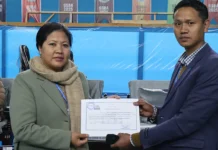Monday Musing
[ Junroi Mamai ]
There have been protests over the government’s decision to auction the proposed Namchik east and Namchik west coal blocks, which are extensions of the Namchik-Namphuk coalfield. The Namchik-Namphuk coal mine was auctioned in November 2022 for commercial mining, and Coal Pulz Pvt Ltd recently won the bid. The locals are strongly protesting the auction of the coal mines and urging the state government to put an immediate halt on the auction process.
Owing to these mining projects, a large number of local indigenous people will be losing their ancestral land and face mass displacement. Also, there will be irrevocable environmental degradation in the form of deforestation, soil erosion and water contamination from the mining activities which threaten local biodiversity and the health of ecosystem that tribal communities rely on. Mining activities also disrupt livelihoods of the indigenous people who depend on forest for their food, medicine and cultural practices.
The degradation of these natural resources directly undermines their way of life.
Sadly, the locals are already facing the brunt of over a decade of incessant oil and coal mining activities being carried out, especially in Kharsang area of Changlang district. Crude oil extraction by the Oil and Natural Gas Corporation (ONGC) has been going on in Kharsang for decades, while other private companies like GeoEnpro Petroleum Ltd, alongside other conglomerates have been extracting crude oil and coal through open pit method in the area for many years. These sustained mining activities have resulted in the depletion of drinking water sources as well as massive pollution of rivulets and ground water sources in Kharsang and adjoining areas.
Coal combustion is also one of the largest sources of carbon dioxide emissions that exacerbate global warming and trigger extreme weather events. The extraction process itself often leads to significant ecological disruption.
Local activists and environmental experts often call for stringent regulatory frameworks, sustainable mining practices, and meaningful consultation with affected communities. For indigenous forest dwellers, the stakes are particularly high, as the future of both their lands and traditions hangs in the balance. The government needs to take the indigenous people into confidence first and ensure that indigenous populations have a decisive voice in mining projects to help them preserve their cultural heritage and secure their environmental rights as well.
The government should also implement rigorous environmental standards and rehabilitation programmes that can reduce the ecological footprint of mining operations. There should also be research into carbon capture and alternative energy sources that could mitigate the environmental impacts of coal in order to ease the country’s transition to a greener economy.
In today’s era, when climate change poses an existential threat, the future of coal mining is under intense scrutiny. Governments and industry leaders are increasingly pressured to balance economic imperatives with environmental stewardship. The coal mining industry still remains emblematic of the broader struggle between economic development and environmental conservation. The path forward will require a thoughtful re-evaluation of priorities, one that honours both human progress and the preservation of our natural world.



